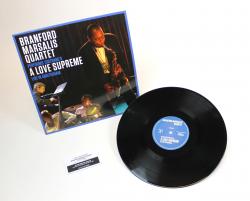 Coltrane’s A Love Supreme: Live in Amsterdam reissue from the Branford Marsalis Quartet out now and available on vinyl for the very first time Read more »
Coltrane’s A Love Supreme: Live in Amsterdam reissue from the Branford Marsalis Quartet out now and available on vinyl for the very first time Read more »
Fine Plena Indeed: Esta Plena is notable for the quality of the jazz musicianship and the infectious rhythm of the panderos.
Date: 10.30.2009
Publication: World Music Central
Author: Angel Romero
If Marsalis Music signs you, it means you are above average in the world of American jazz. Puerto Rican saxophonist Miguel Zenón proved his worth at a young age. Last year Zenón was granted both a MacArthur and a Guggenheim Fellowship in 2008 and he has already recorded four albums for the reputable Marsalis Music. The latest release is Esta Plena. As the name implies, this recording is dedicated to one of the great musical traditions of Puerto Rico, the plena, reinterpreted with the approach of 21st century jazz.
Esta Plena is the direct result of the Guggenheim Fellowship, awarded to him for musical composition. It recognized Zenón for “drawing from a variety of jazz idioms and the music of his native Puerto Rico to create complex, accessible sounds that overflow with emotion.” Esta Plena follows Jibaro another recording in which Zenón was inspired by the music of Puerto Rico. While Jibaro focused on the country music of the Caribbean island, Esta Plena is dedicated to the pandero(frame drum)-driven rhythm. Plena was created in the 19th century in Ponce, a city in the southern coast of Puerto Rico. “It is definitely connected to the idea behind Jibaro, in that we took something that was very folkloric and put it in a jazz context,” says Zenón, “but on this record we went a step further by incorporating some of the actual instruments used in the music which are so central to this style. Because of the Guggenheim, I was able to do more extensive research, go deeper than I had for Jibaro.”
“Initially, what drove these projects was a personal desire to know more about my own culture,” he says. “After I left Puerto Rico, I immersed myself in jazz for a very long time so I wasn’t really dealing with Puerto Rican music. I had been exposed to it growing up, but it wasn’t until I began writing my own music that I really started to pay close attention to it. That’s when I decided to explore this music and find out more about my roots, who I really am, where I came from… and I felt it was important to study it at a very fundamental, core level. That’s how these projects were born.”
In his liner notes, Zenón defines plena as “a by-product of Spanish colonization, combining African rhythmic syncopations with European harmonies and melodic cadences.” The pleneros, or plena singers, “described the events of everyday life as experienced by the impoverished classes of the Puerto Rican population,”’ explains Zenón. “These lyrics eventually expanded to include themes of patriotism, social protest, love, humor, and just plain appreciation for the plena and the pandero.”
When you listen to Esta Plena you get the sensation that there are two bands playing in the album, his standard jazz quartet and a Puerto Rican plena group. Zenón has been working for the past five years with the same quartet comprised of Luis Perdomo, piano; Hans Glawischnig, bass; and Henry Cole, drums. “I’ve been so lucky to have the same group to work with all this time,” says Zenón. “When you play with people for so long you basically know how they play, how they are going to react and how they might bring their personalities to a tune. So after awhile, you are definitely writing for specific musicians, for how they are going to play it.”
Half of the tracks in Esta Plena have lyrics and are sung. “At first, I was not going to write any lyrics,” says Zenón. “I had intended to write instrumental songs. But the more I listened to the music, the more I became interested in writing lyrics. I realized that this was very different from Jibaro because Jibaro music is actually a big family of styles from different regions while plena has only one rhythm; there are no variations. So, I was trying to find different ways to use that rhythm and bring variety to the music. Adding lyrics helped me do that.”
The powerful rhythm of the panderos are the main drivers of the album. “Of course, it’s my recording so I take solos, but when I wrote the music, everything came from those drums and that pattern that defines plena. The saxophone is there to add texture, especially in the songs with lyrics.”
“Having the folk roots gives the music a firm ground and gives me a lot of freedom to try a lot of things but still have that solid base,” says Zenón. “That folkloric root is so essential in music. It’s the purest music It’s not music played by trained musicians but music played by regular people. This is music from the people. This is music that can start a party anywhere. It’s simple and basic, and accessible, but at the same time, it’s so deep. That’s what we want to do with this record: try to keep the music out, in the street.”
Esta Plena is notable for the quality of the jazz musicianship and the infectious rhythm of the panderos.
Categories
Tags in Tags
Branford Marsalis Branford Marsalis Quartet ellis marsalis four mfs playin' tunes Joey Calderazzo Justin Faulkner Marsalis Family marsalis music metamorphosen miguel zenon music redeems new orleansFilter by Artist
Marsalis Music Radio
Join Our Mailing List
- RT @bmarsalis: Compliments of the @T_Blanchard archives. https://t.co/4RsXbyEloa — 3 years 9 weeks ago MarsalisMusic